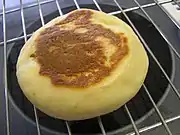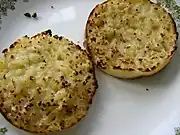English muffin
An English muffin is a small, round and flat yeast-leavened (sometimes sourdough) bread which is commonly 4 in (10 cm) round and 1.5 in (4 cm) tall. It is generally sliced horizontally and served toasted.[2] In North America, Australia and New Zealand, it is frequently eaten with sweet or savoury toppings such as butter, fruit jam, honey, eggs, sausage, bacon, or cheese. English muffins are an essential ingredient in eggs Benedict and a variety of breakfast sandwiches derived from it, such as the McMuffin, and can be used in place of other breads for French toast.
 A split and toasted English muffin | |
| Alternative names | Breakfast muffin, muffin |
|---|---|
| Type | Leavened bread |
| Course | Breakfast |
| Place of origin | United Kingdom[1] |
| Main ingredients | Wheat flour, butter, milk, sugar, salt, egg, yeast |
In various parts of the world, these products are commonly called English muffins to distinguish them from the sweeter cupcake-shaped products also known as muffins. English muffins are available in a wide range of varieties, including whole wheat, multigrain, cinnamon raisin, cranberry, and apple cinnamon.
Origin

The word muffin is thought to come from the Low German muffen, meaning "little cakes".[3] The Oxford English Dictionary also suggests a possible link to Old French moflet, a type of bread. Originally it meant "any of various kinds of bread or cake".[4]
The first recorded use of the word muffin was in 1703,[5] and recipes for muffins appear in British cookbooks as early as 1747 in Hannah Glasse's The Art of Cookery. The muffins are described as being "like a Honey-comb" inside.[6]
In the Oxford Companion to Food, Alan Davidson states that "[t]here has always been some confusion between muffins, crumpets, and pikelets, both in recipes and in name".[7] The increasing popularity of flatbread muffins in the 19th century, is attested by the existence of muffin men, a type of hawker who would travel door to door selling English muffins as a snack bread before most homes had their own ovens.[7]
Bell ringing

The bell-ringing of muffin men became so common that by 1839, the British Parliament passed a bill[8] to prohibit bell ringing by muffin men, but it was not adhered to by sellers. In 1861, "goodsized" muffins from street-sellers were commonly sold for a halfpenny each; crumpets were about a penny.[9]
In popular culture
The traditional English nursery rhyme "The Muffin Man", which dates from 1820 at the latest, traces to that custom.[10]
A well-known reference to English muffins is in Oscar Wilde's 1895 play The Importance of Being Earnest.[11]
By country
United Kingdom

English muffins are usually referred to simply as muffins in the UK; sweet American-style muffins are occasionally referred to as American muffins to differentiate.[12][13] They are usually consumed with tea or coffee, and sometimes feature in afternoon tea served in UK hotels.[14][15][16] They are also consumed for breakfast in the form of American-style breakfast sandwiches.[17][18][19]
United States
"Mush muffins (called slipperdowns in New England) were a Colonial [American] muffin made with hominy on a hanging griddle."[20] These and other types of flatbread muffins were known to American settlers, but they declined in popularity with the advent of the quickbread muffin.
References to English muffins appear in U.S. newspapers starting in 1859,[21][22][23] and detailed descriptions of them and recipes were published as early as 1870.[24][25]

A popular brand of English muffin in the U.S. is Thomas', which was founded by English immigrant Samuel Bath Thomas in 1880. Thomas opened a second bakery around the corner from the first at 337 West 20th Street in a building that remains known as "The Muffin House".[26] Today the company is owned by Bimbo Bakeries USA, which also owns the Entenmann's, Boboli, Stroehmann, Oroweat, and Arnold brands.[27]
Foster's sourdough English muffins were a popular brand of English muffin originally from San Francisco. They were a signature menu item at Foster's restaurants from the 1940s to the 1970s, and continued to be produced as a packaged brand until 2008.
Portugal
English muffins are very similar to the Portuguese bolo do caco.
Preparation of English muffins
 The dough is relatively wet, and cannot be shaped as a bread dough could be.
The dough is relatively wet, and cannot be shaped as a bread dough could be. It is placed in rings on a griddle or pan and then cooked.
It is placed in rings on a griddle or pan and then cooked. The resulting muffins are cooled before eating.
The resulting muffins are cooled before eating. They are then cut in half; the texture has a small crumb, and is unlike bread dough.
They are then cut in half; the texture has a small crumb, and is unlike bread dough. The halved muffins are usually toasted and spread with butter.
The halved muffins are usually toasted and spread with butter.
See also
- Crumpet
- Scone
- Muffin – a sweet quickbread (in American English)
- List of breads
- List of British breads
References
- "The Art of Cookery Made Plain and Easy". Intenet Archive. Retrieved 19 July 2020.
- David, Elizabeth (1977). English Bread and Yeast Cookery. London: Allen Lane. ISBN 0713910267
- "muffin". Retrieved 29 December 2016 – via The Free Dictionary.
- "muffin, n.". OED Online. March 2022. Oxford University Press. https://www.oed.com/view/Entry/123299 (accessed April 02, 2022).
- "Merriam-Webster".
- Glasse, Hannah (1758). The Art of Cookery. London: A. Millar and T. Tyre. pp. 298–299.
- Davidson, Alan. Oxford Companion to Food. Oxford University Press:Oxford, 1999 (p. 517)
- "Paragraph 14 of section 54 of the Metropolitan Police Act 1839".
- "London Labour and the London Poor, Volume 1 1861". hdl:10427/53837.
- "London Sound Survey". Retrieved 11 February 2019.
- "Oscar Wilde: The Importance of Being Earnest". literaturepage.com. Retrieved 18 November 2022.
Well, I can't eat muffins in an agitated manner. The butter would probably get on my cuffs.
- Myers, Dan (2 February 2018). "In England, English muffins are just called 'muffins'". Los Angeles Times. Retrieved 27 February 2023.
- "Restricting promotions of products high in fat, sugar and salt by location and by price: government response to public consultation". www.gov.uk. Retrieved 27 February 2023.
- Mason, Laura; Brown, Catherine (1999). From Bath Chaps to Bara Brith. Totnes: Prospect Books.
- Pettigrew, Jane (2004). Afternoon Tea. Andover: Jarrold.
- Fitzgibbon, Theodora (1972). A Taste of England: The West Country. London: JM Dent.
- "Breakfast Menu". mcdonalds.com. Retrieved 27 November 2022.
- "Wetherspoon Breakfast Hours and Menu". breakfasthours.co.uk. 13 January 2022. Retrieved 27 November 2022.
- "Mushroom & Egg Muffin". starbucks.co.uk. Retrieved 27 November 2022.
- Mariani, John F. Encyclopedia of American Food and Drink, [Lebhar-Freidman Books: New York]. 1999 (p. 211)
- "Thomas' Dining Saloon". The Buffalo Daily Republic. 22 September 1859. p. 2. Retrieved 25 February 2018 – via Newspapers.com.

- "Wanted: An English Muffin and Crumpet Baker". New York Daily Herald. 17 September 1862. p. 2. Retrieved 25 February 2018 – via Newspapers.com.

- "Call at Steam Bakery". The Philadelphia Inquirer. 30 May 1863. p. 5. Retrieved 25 February 2018 – via Newspapers.com.

- "Fancy Bread". The Brooklyn Daily Eagle. 4 November 1870. p. 1. Retrieved 25 February 2018 – via Newspapers.com.

- "English Muffins". The Weekly Star. 29 March 1876. p. 6. Retrieved 25 February 2018 – via Newspapers.com.

- Muffin House -Daytonian
- "Bimbo Bakeries - Our Brands".
- Based on a recipe by Alton Brown in "The Muffin Man" episode of the television cooking show Good Eats